
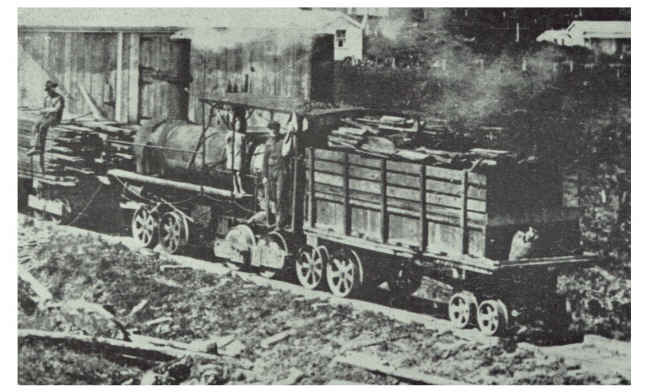
1911 0-4-4-0 Heavy
The picture depicts a Stuart & Chapman Davidson working at Ruru.
This lokey is fitted with an ex-NZR F type boiler. (B.Thiem)
General dimension of these lokeys were: - Length 20’-0½” (6109 mm), Wheelbase 11’-1” (3378 mm),
Truck wheelbase 2’-10” (864 mm), Cylinders 9” x 18” (228 x 456 mm), Wheel diam. 25” (635 mm).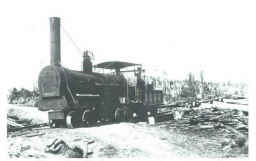 The Davidsons did not have sufficient room in or
around their cabs for wood fuel and water, therefore it was left up to the customer
to build, usually a four-wheel tender on which was mounted a water tank which was then
piled high with wood slabs. Some tenders sported eight wheels in two trucks, while a
few extended the chain drive from the rear axle onto the leading axles of the eight-wheel
tender and thus provided extra adhesion and traction. Builder’s numbers were not used
nor were definite records kept so it is difficult to identify all Davidson locomotives.
The Davidsons did not have sufficient room in or
around their cabs for wood fuel and water, therefore it was left up to the customer
to build, usually a four-wheel tender on which was mounted a water tank which was then
piled high with wood slabs. Some tenders sported eight wheels in two trucks, while a
few extended the chain drive from the rear axle onto the leading axles of the eight-wheel
tender and thus provided extra adhesion and traction. Builder’s numbers were not used
nor were definite records kept so it is difficult to identify all Davidson locomotives.
The rest of the lokey was fairly primitive. The boilers usually left the works unlagged but some of the operators covered them with lengths of timber. The cab was just a slightly curved roof supported by six upright pipes. The design of the tender seemed to be left to the customer to work out. The average service life of the Davidson was 17 years and only one remains today, that being on display at Mawhera Reserve near Ngahere.
1911 0-4-4-0 Light
The photo shows the Whakamarama Land & Timber Co.'s Davidson working the
wharf at Omokoroa near Tauranga (Bob Young col.)
General dimensions: - Length19’-1” (5829 mm), Wheelbase 11’-3” (3429 mm),
Truck wheelbase 2’-10” (864 mm).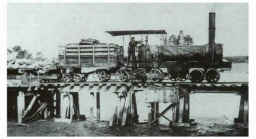 This photograph clearly shows some of the detail of the drive mechanism.
The two
horizontal pistons drove a cross crankshaft on which was mounted a small spur gear.
This meshed with the large one that is visible which was mounted on a cross shaft
fitted with a sprocket. This sprocket in turn drove the truck axles by means of Davidson’s
patented chain. The slack in the chains is clearly visible. Note also that the chain drive
has been taken to the lead axle of the tender and that axle is linked to the rear truck
by means of a connecting bar.
This photograph clearly shows some of the detail of the drive mechanism.
The two
horizontal pistons drove a cross crankshaft on which was mounted a small spur gear.
This meshed with the large one that is visible which was mounted on a cross shaft
fitted with a sprocket. This sprocket in turn drove the truck axles by means of Davidson’s
patented chain. The slack in the chains is clearly visible. Note also that the chain drive
has been taken to the lead axle of the tender and that axle is linked to the rear truck
by means of a connecting bar.
Davidson had three classes of locomotives – ‘light’, ‘heavy’, and ‘others’. Boilers on
light classes were all fitted with ex-NZR ‘D’ class boilers while the heavy class used
ex-NZR boilers from ‘F’ class locomotives. The ‘others’ used boilers from other manufacturers,
e.g. Dispatch, Scott, etc.
The 1908 model Davidson had two horizontal cylinders mounted on top of the chassis at
the forward end of the loco. These drove back to a crankshaft mounted across the frame
under the boiler. From there a reduction gear set transferred the power to another shaft
mounted transversely almost under the crankshaft and from these two underslung shafts,
chains were used to transmit the drive down to the nearest axle of the two trucks. A
further chain then drove the outermost axle from its companion.
Again in 1908, a further lokey had slightly inclined cylinders mounted outside the frame
below the smokebox driving to an underslung shaft coupled to two gear wheels on two
countershafts, and from there, the patented chains drove the nearest axle on each truck.
This arrangement followed on the 1911 engine but the trucks were wider spread as difficulty
had been experienced with lack of chain flexibility required for the trucks to negotiate
sharp track curves. Truck centres were increased from 8’-3” to 11’-1”. Steam brakes were
fitted.
The Patented Davidson Chain

Devised by George Davidson and patented, the chain was so made that all loadings were not carried on the pivot pins, but by shoulders machined into the links. In the original chain, sprocket wheels used were of the flat or single disc type with teeth at every link (i.e. on a pitch of 4”). It was necessary to adapt the chain for use on the bush lokeys so that misalignment could be accepted, so the sprocket wheels were a double-flanged type with the chain run between them and the teeth protruding from the bottom of the groove into every second link (i.e. on a pitch of 8”).
1912 0-4-4-0 Heavy
This is the Selwyn Timber Co. Davidson working the bush at Mangatapu. Note wood-rail type
wheels used on steel rail,
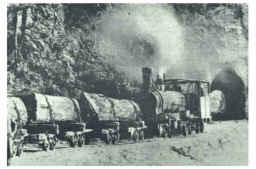 This locomotive has been fitted, by its owner,
with a four-wheel tender for water and fuel. Note also that the wheels fitted are
those for a wooden track although it appears that steel rails are used. The timber-lagged
boiler became a fairly standard practise for owners in an endeavour to increase the
efficiency.
This locomotive has been fitted, by its owner,
with a four-wheel tender for water and fuel. Note also that the wheels fitted are
those for a wooden track although it appears that steel rails are used. The timber-lagged
boiler became a fairly standard practise for owners in an endeavour to increase the
efficiency.
(W.W. Stewart col.)
1916 0-4-4-4-0 Heavy 12-Wheeler
The loco is shown when brand new at Gamman Brothers show at Oropi. (MOTAT col.)
Dimensions: - Length 24’-6½” (7480 mm), Wheelbase 16’-4” (4978 mm), Truck wheelbase –
front 3’-2” (965 mm), rear 2’-10” (864 mm), Weight 17 tonnes, Boiler pressure 140 psi (965 kPa),
Cylinders 9” x 18” (228 x 456 mm), Wheel diam. 30” (762 mm).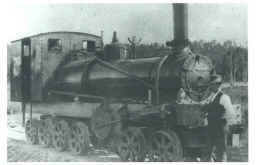 Davidson built two of this model and the locomotive
was able to carry all of its fuel on board, therefore doing away with a separate tender.
Because of the extra weight, and to keep the axle loading within prescribed limits, the
loco was given extra four wheels under the rear of the frame. All twelve wheels were
chain driven with the rear two trucks mounted on a swivelling beam. The water tank was
placed between the frame members and wood fuel was carried on top of the tank and
across the rear of the cab. The cab was also a first, drivers must have complained about
the lack thereof on earlier Davidson locomotives.
Davidson built two of this model and the locomotive
was able to carry all of its fuel on board, therefore doing away with a separate tender.
Because of the extra weight, and to keep the axle loading within prescribed limits, the
loco was given extra four wheels under the rear of the frame. All twelve wheels were
chain driven with the rear two trucks mounted on a swivelling beam. The water tank was
placed between the frame members and wood fuel was carried on top of the tank and
across the rear of the cab. The cab was also a first, drivers must have complained about
the lack thereof on earlier Davidson locomotives.
Photo 1 - An early Davidson, possibly a 1908 model at the Stratford & Blair operation at Hukarere. Note wooden rails. (Alan Bellamy col.)
Photo 2 - 1911 Davidson. Note wooden lagged boiler, wide tread wheels and four-wheel tender for water and fuel. This may be the Selwyn Timber lokey.
Photo 3 - A 1908 Davidson at Snowy River. Note the slack chains.
Photo 4
- A 1908 Davidson ready to leave the works. (B. Thiem)
The Survivor
